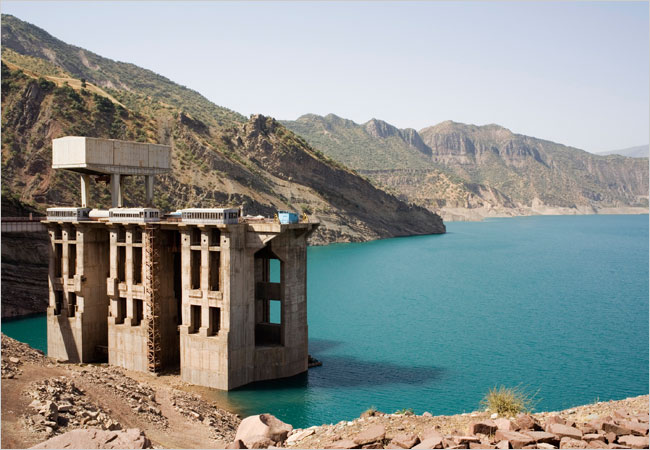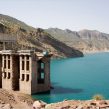
Controversy Intensifying Over the Construction of Dams in Central Asia
Publication: Eurasia Daily Monitor Volume: 6 Issue: 88
By:

Following the meeting of the leaders from the five Central Asian states in Almaty on April 28, discussions continue over the future direction of transnational water management. While the Kyrgyz and Tajik regimes are keen to build large water dams to increase electricity production, their neighbors, particularly Uzbekistan, are sternly against any new construction. Both Tajikistan and Kyrgyzstan see these projects as vital for their economic and political development, yet are warned by the international community that the new dams will increase instability in the region, and instead alternative solutions should be sought.
In Tajikistan, the construction of the Rogun dam, potentially the highest in the world, has turned into a matter of national pride. Government officials, as well as local experts, treat Rogun as an ultimate solution to lift the country out of poverty, decrease its dependence on its larger neighbors, as well as contributing to the stabilization of Afghanistan through electricity exports. "After constructing Rogun, Tajikistan will be like Kuwait" a representative of the Tajik government energy company Barki Tochik told Jamestown.
However, Tajikistan’s plans have not been welcomed by Tashkent, which blames President Emomali Rakhmon for replicating the Soviet experience of constructing vast dams. The Uzbek government has insisted that the 350-meter projected dam is not cost effective and poses serious environmental risks. The construction of Rogun, according to Tashkent, poses a potential national threat to Uzbekistan since it will be located on a seismic zone and may flood its densely populated territories.
Tajikistan, in turn, views Uzbekistan as a direct threat to its energy security. Indeed, the country imports most of its natural gas from Uzbekistan and its electricity transmission grid also passes through Uzbek territory. For the Tajik side, Uzbekistan’s speculation over the potential dangers of Rogun seems to reflect fears in Tashkent that the project will decrease its leverage over Dushanbe. Uzbekistan increased the prices for natural gas to $240 per thousand cubic meters when Kyrgyzstan and Tajikistan were both enduring severe energy crises in the winter of 2008-2009.
As a reaction to both the crisis and increasing gas prices, Rakhmon has been emphasizing the significance of Rogun. "It is now the primary objective of the Tajik government," the Barki Tochik representative declared. With an upsurge in Tajikistan’s attention to achieving energy independence, Uzbek president Islam Karimov has been using regional platforms to condemn Rakhmon’s plans. The dispute reflects the deep antagonism and lack of trust between the two leaders. Both regard energy security issues as a matter of regional pride, with Uzbekistan wanting to retain its leverage and Tajikistan seeking greater independence.
Recently EU officials have confirmed Uzbekistan’s fears that Rogun does entail high risks, warning Tajikistan that the dam replicates the past reckless Soviet industrial planning, and disregards human security. In Dushanbe, experts showed their disappointment with the EU, saying that instead of helping the Central Asian leaders to agree on a mutually-beneficial solution, the EU has adopted a more narrow-minded approach (www.asia-plus.tj, April 30).
Yet other Central Asian experts criticize the EU stance for its interest in Uzbekistan’s gas for the prospective Nabucco pipeline, which plans to connect the South Caucasus and Central Asia with Europe via Turkey. According to this view, the EU condemned Russia’s $1.7 billion credit to Kyrgyzstan for the construction of Kambarata-1 hydropower station in February. Then, EU officials mentioned that there are opportunities, other than Russia, to improve the state of the hydropower sector in Kyrgyzstan.
Following the summit, Kyrgyz president Kurmanbek Bakiyev confirmed that the construction of the Kambarata-1 and Kambarata-2 hydropower stations is the foremost priority for the country. Both stations will be constructed even "if others like it or not," obliquely referring to Karimov’s remarks during the April 29 summit.
The dynamics of the tense relationships between upstream Kyrgyzstan and Tajikistan with downstream Uzbekistan are unlikely to change while the current leaders remain in power. Today, the construction of the Kambarata projects seems more financially viable, compared with the Rogun dam. Along with the calls for completing Rogun, the Tajik government lacks both the resources and expertise. Whether Kyrgyzstan will use Russian credit efficiently remains to be seen.
There are local critics of both the Kyrgyz and Tajik regimes. In Kyrgyzstan, energy experts argue that the Kambarata dams are too expensive. Instead, Kyrgyzstan must explore developing its coal industry. In Tajikistan, few experts recommend that the government should explore alternative energy technologies rather than pursuing Rogun. Both Kyrgyzstan and Tajikistan, however, lack public debate over how water resources must be managed. Such decisions are made by the few people in government. As it now stands, neither country will be able to complete the construction of the planned dams without external financial and technological support.




